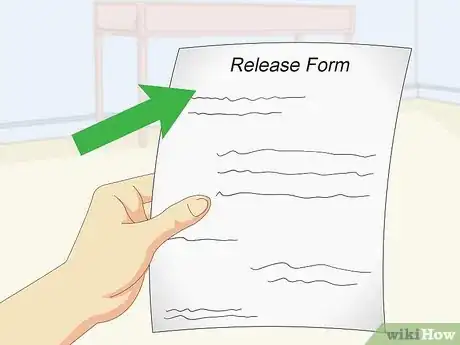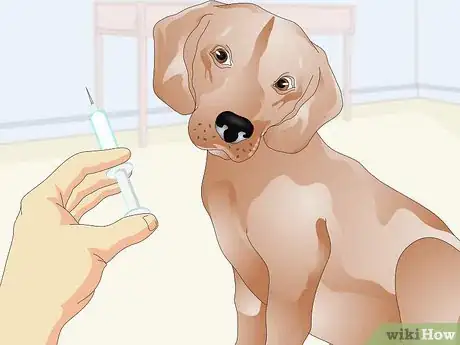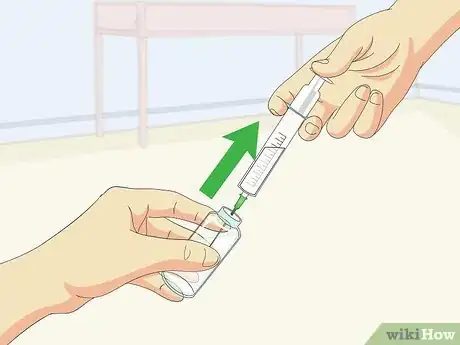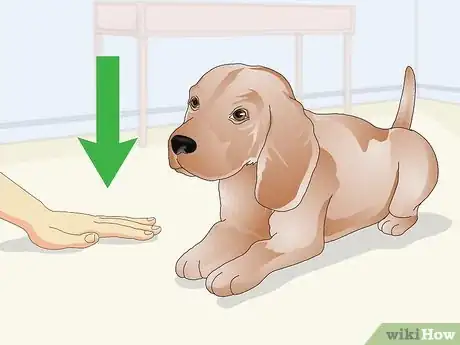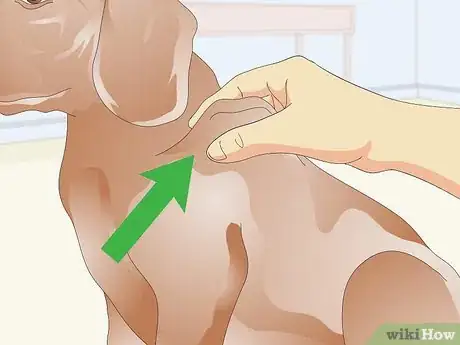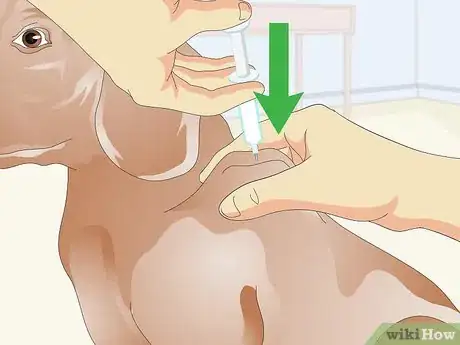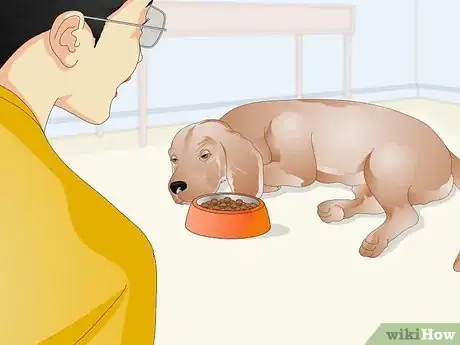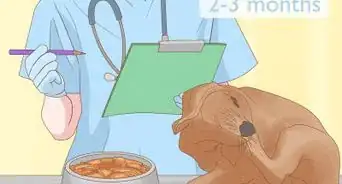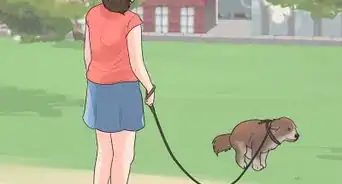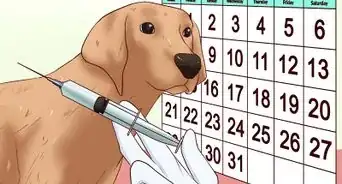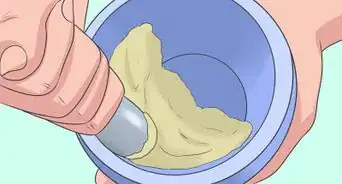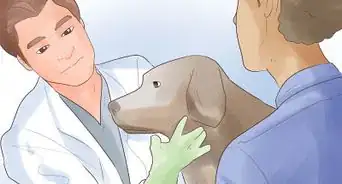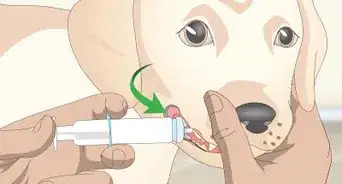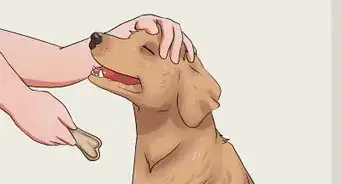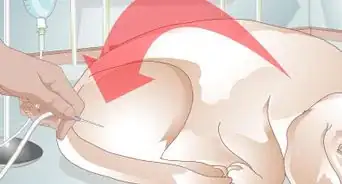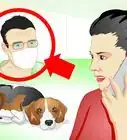This article was co-authored by Ray Spragley, DVM. Dr. Ray Spragley is a Doctor of Veterinary Medicine and the Owner/Founder of Zen Dog Veterinary Care PLLC in New York. With experience in multiple institutions and private practices, Dr. Spragley’s specializations and interests include non-surgical management of cranial cruciate ligament tears, Intervertebral Disk Disease(IVDD), and pain management in osteoarthritis. Dr. Spragley holds a BS in Biology from SUNY Albany and has a Doctor of Veterinary Medicine degree (DVM) from Ross University School of Veterinary Medicine. He is also a Certified Canine Rehabilitation Therapist (CCRT) through the Canine Rehab Institute as well as a Certified Veterinary Acupuncturist (CVA) through Chi University.
This article has been viewed 191,589 times.
Sometimes, dogs needs shots. Vaccinations that protect against a variety of diseases come in shot form and some medications need to be administered via injections. If you're interested in administering shots on your own, there are benefits. Having shots at home might reduce your dog's stress level. It can also lessen vet costs for you. However, makes you know the proper protocol before giving your dog a shot. You want to make sure you administer it correctly to leave your dog happy and healthy.
Steps
Preparing for the Shot
-
1Review the release forms. When you purchase vaccinations or other medicines from a veterinarian to administer yourself, you will have to sign a release form. Read this form carefully. Not only does it provide valuable information, it helps you understand your responsibilities when you decide to administer shots yourself.
- By signing the release form, you accept full responsibility for your pet's injection and any reactions or accident that might occur. It warns that allergic or other life-threatening reactions can occur even if the shot is administered correctly.[1]
- The form warns the shot may be ineffective if it is outdated, left unrefrigerated too long, improperly administered, or exposed to heat, sunlight, or freezing temperatures.[2]
- Some forms state that if you administer your own rabies vaccine, it will not be accepted as valid by law enforcement agencies and animal care professionals. Make sure you know if this clause is present in your form and its repercussions. Your dog will legally be considered unvaccinated for rabies, which means many kennels will not let your board there and you may not be able to adopt other dogs from animal shelters depending on their policies.[3]
-
2Introduce your dog to the syringe beforehand. If your dog has previously been given shots at a vet's office, they probably associate syringes with pain and discomfort. To combat this, allow them to look at, sniff, and paw at an empty syringe (with no attached needle) at a comfortable place in your home.[4]
- Give treats and other forms of positive reinforcement during these sessions, such as attention, praise, and play. You want your dog to associate the syringe with positive moments to reduce fear and stress when you actually administer the shot.[5]
Advertisement -
3Combine the liquid and powder. Some substances used in shots, especially vaccines, come in two vials: a liquid vial and a powder vial. The liquid and powder needs to be mixed before the shot is administered.
- Insert the syringe's needle into the liquid vial and pull up the plunger until all the liquid is in the syringe.
- Push the syringe into the vial containing the powder. Make sure all the liquid empties before pulling out the syringe.
- Shake the vial. Make sure the powder is completely dissolved. There should be no clumps or residue collected at the bottom of the vial.
-
4Draw the desired amount. You should know how many milliliters of medicine or vaccination you are administering to your dog. Before giving him the shot, draw out that amount.
- Insert the syringe into the combined liquid and powder vial. Pull up until you have the desired amount of milliliters.
- Make sure there are no air bubbles. If you notice any, push the syringe down, empty the vial, and try again.
Administering the Vaccination
-
1Familiarize yourself with the three types of injections. Thought there are three different types of injections given to dogs, there is only one type — subcutaneous shots — that can potentially be administered by someone other than the vet. If you shot you plan to give your dog does not fall into this category, then you must take them to the vet.
- Subcutaneous vaccines are given just beneath the skin. The majority of vaccines and shots are subcutaneous. These are usually administered on the loose skin just above a dog's shoulder blades. If you're administering shots yourself, always use the subcutaneous method.[6] If the medication or vaccination specifically states it needs to be injected in another manner, take your dog to the vet's office.[7]
- Intramuscular vaccines are injected into the muscle. If you're not a veterinary professional, it might be hard to locate a muscle on your own. It is best to take your dog to the vet if he needs an intramuscular vaccine.[8]
- Intravenous injections must also be administered by a vet. These injections must be injected into a vein and you should not attempt to do this yourself. Vaccines are not given by IV injection.
-
2Find a flat surface. A hard, flat surface should be used when administering shots to your dog.
- A flat surface, such as a counter or table, allows you plenty of room while administering the medication. Find something that allows you to work comfortably.
- Have a friend or family member present. Even if your dog is normally calm, he might fidget or fight if he feels a prick. Someone should be present to hold the dog during the injection. This is particularly important if your dog is small and might leap off the table or counter.
-
3Lift the dog's skin up and form a pocket in their skin with your finger. As you'll be using a subcutaneous vaccine, it's best to administer it on the loose skin found behind the shoulder blade.[9]
- Using your non-dominant hand, lift the skin upward, away from the shoulder blade. Using your index or middle finger of your dominant hand (which is holding the syringe), angle the needle at 90 degrees to the flat tented surface of the skin. Push inward to form a small pocket of skin. This reduces the risk of accidentally administering a shot into the body or catching sensitive areas.
-
4Administer the shot. Press the needle into your dog's skin.
- Before injecting, pull the plunger out a little bit. If you see any blood being draw, you're in a vein. This could cause harm to the dog. Pull out, refill the syringe with fresh medicine, and insert it again.
- Once you find a safe spot, slowly push the plunger down until all the liquid is gone.
Observing the Dog Afterwards
-
1Watch for skin reactions. Some soreness after an injection is normal, but it also sometimes be a sign of infection or allergic reaction. Monitor the skin after injection for any signs of a serious reaction.
- Mild reactions are very common and come in the form of a lump or swelling around the site of the injection. This may last a few hours, but might also stay for up to a week.
- If you notice hives, rashes, or swelling that occurs anywhere outside the injection location, such as the head or shoulder blades, seek medical care. This is a sign of a severe reaction and requires medical care.
-
2Understand reactions are common. Reactions to injections, especially vaccinations, are very common. For the most part, the benefits outweigh the risks involved. However, your dog may exhibit a number of mild symptoms that should go away within a week.
- Fatigue and a low grade fever are common reactions to an injection. Your dog might be lethargic and have a low appetite during the days following an injection.[10]
- Your dog might also be sore in the area surrounding the injection. Be careful handling him after his shots, especially if you have any contact with his shoulder blades.[11]
-
3Know when you need immediate veterinary care. Severe allergic reactions are rare, but can occasionally occur. If a severe allergic reaction does occur, it will usually be within 20 - 30 minutes of giving the injection and the most common sign is collapse. If your dog exhibits any of the following symptoms, seek immediate medical care:
- Vomiting
- Diarrhea
- Lameness
- Collapse
- Seizure[12]
Expert Q&A
-
QuestionWhere are vaccines injected in dogs?
 Ray Spragley, DVMDr. Ray Spragley is a Doctor of Veterinary Medicine and the Owner/Founder of Zen Dog Veterinary Care PLLC in New York. With experience in multiple institutions and private practices, Dr. Spragley’s specializations and interests include non-surgical management of cranial cruciate ligament tears, Intervertebral Disk Disease(IVDD), and pain management in osteoarthritis. Dr. Spragley holds a BS in Biology from SUNY Albany and has a Doctor of Veterinary Medicine degree (DVM) from Ross University School of Veterinary Medicine. He is also a Certified Canine Rehabilitation Therapist (CCRT) through the Canine Rehab Institute as well as a Certified Veterinary Acupuncturist (CVA) through Chi University.
Ray Spragley, DVMDr. Ray Spragley is a Doctor of Veterinary Medicine and the Owner/Founder of Zen Dog Veterinary Care PLLC in New York. With experience in multiple institutions and private practices, Dr. Spragley’s specializations and interests include non-surgical management of cranial cruciate ligament tears, Intervertebral Disk Disease(IVDD), and pain management in osteoarthritis. Dr. Spragley holds a BS in Biology from SUNY Albany and has a Doctor of Veterinary Medicine degree (DVM) from Ross University School of Veterinary Medicine. He is also a Certified Canine Rehabilitation Therapist (CCRT) through the Canine Rehab Institute as well as a Certified Veterinary Acupuncturist (CVA) through Chi University.
Veterinarian Shots are usually injected subcutaneously (in the space underneath the skin before reaching the muscle) between the shoulder blades. Dog skin tends to be fairly loose, so you can pull it upward and administer the shot right beneath the skin
Shots are usually injected subcutaneously (in the space underneath the skin before reaching the muscle) between the shoulder blades. Dog skin tends to be fairly loose, so you can pull it upward and administer the shot right beneath the skin -
QuestionI gave my puppy his shot in the back leg, but didn't lift the skin. How would I know if I injected the needle too far?
 Pippa Elliott, MRCVSDr. Elliott, BVMS, MRCVS is a veterinarian with over 30 years of experience in veterinary surgery and companion animal practice. She graduated from the University of Glasgow in 1987 with a degree in veterinary medicine and surgery. She has worked at the same animal clinic in her hometown for over 20 years.
Pippa Elliott, MRCVSDr. Elliott, BVMS, MRCVS is a veterinarian with over 30 years of experience in veterinary surgery and companion animal practice. She graduated from the University of Glasgow in 1987 with a degree in veterinary medicine and surgery. She has worked at the same animal clinic in her hometown for over 20 years.
Veterinarian If the needle was placed too deep and went into the muscle, the most likely complication is the puppy may scream or cry. Intramuscular injection is more painful, and there is a risk of accidentally injecting into a blood vessel or piercing a nerve. If the case of the former, the dog may have a shock type reaction and faint or collapse; in the latter, the pup may limp or have a numb leg (which may be temporary or permanent).
If the needle was placed too deep and went into the muscle, the most likely complication is the puppy may scream or cry. Intramuscular injection is more painful, and there is a risk of accidentally injecting into a blood vessel or piercing a nerve. If the case of the former, the dog may have a shock type reaction and faint or collapse; in the latter, the pup may limp or have a numb leg (which may be temporary or permanent). -
QuestionHow do I give a Percorten injection?
 Pippa Elliott, MRCVSDr. Elliott, BVMS, MRCVS is a veterinarian with over 30 years of experience in veterinary surgery and companion animal practice. She graduated from the University of Glasgow in 1987 with a degree in veterinary medicine and surgery. She has worked at the same animal clinic in her hometown for over 20 years.
Pippa Elliott, MRCVSDr. Elliott, BVMS, MRCVS is a veterinarian with over 30 years of experience in veterinary surgery and companion animal practice. She graduated from the University of Glasgow in 1987 with a degree in veterinary medicine and surgery. She has worked at the same animal clinic in her hometown for over 20 years.
Veterinarian Percorten should be given by intramuscular injection. To do otherwise will interfere with the slow release of this drug, and make it less effective. Percorten should only be given by or under the direction of a vet. Giving an intramuscular injection is a skilled procedure, since there is a risk of hitting a blood vessel or nerve. If you are unclear about how to give the injection safely, speak to your vet, who can show you what to do.
Percorten should be given by intramuscular injection. To do otherwise will interfere with the slow release of this drug, and make it less effective. Percorten should only be given by or under the direction of a vet. Giving an intramuscular injection is a skilled procedure, since there is a risk of hitting a blood vessel or nerve. If you are unclear about how to give the injection safely, speak to your vet, who can show you what to do.
Warnings
- Only attempt subcutaneous injections on your own. The other types are trickier, may require special equipment, and should only be attempted by someone with training in veterinary medicine.⧼thumbs_response⧽
References
- ↑ http://www.petmd.com/dog/care/evr_vaccinating_your_own_dog#
- ↑ http://www.petmd.com/dog/care/evr_vaccinating_your_own_dog#
- ↑ http://www.petmd.com/dog/care/evr_vaccinating_your_own_dog#
- ↑ http://articles.mcall.com/2012-05-06/features/mc-dog-diabetes-insulin-shots-20120506_1_insulin-injections-syringe-ruby
- ↑ http://articles.mcall.com/2012-05-06/features/mc-dog-diabetes-insulin-shots-20120506_1_insulin-injections-syringe-ruby
- ↑ Ray Spragley, DVM. Veterinarian. Expert Interview. 29 June 2021.
- ↑ http://www.drsfostersmith.com/pic/article.cfm?aid=84
- ↑ http://www.drsfostersmith.com/pic/article.cfm?aid=84
- ↑ Ray Spragley, DVM. Veterinarian. Expert Interview. 29 June 2021.
About This Article
Administering a shot to your dog can be a little scary, but by keeping your dog calm and following any instructions your vet gave you, things should go smoothly. Before you begin, read the release form you received from your vet. It will contain important information on how to administer the shot. Then, let your dog see the syringe so it’s not as scared by it. Depending on the type of vaccination, you may need to combine a liquid and powder before you administer it. Fill the syringe with the solution, then form a pocket of skin by pulling up on your dog’s loose skin, usually behind its shoulders. Then, insert the needle into the skin and slowly push the plunger down until the liquid is gone. If blood comes out when you insert the needle, you’ll need to remove the needle, refill the medication, and try another spot. After the injection, watch out for any rashes or swelling, which could be a sign of an infection that your vet will have to treat. For tips from our Veterinary co-author on which injections need to be performed by a vet, read on.
